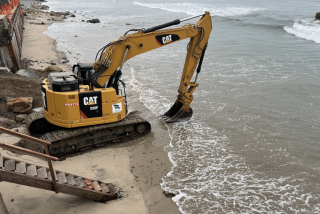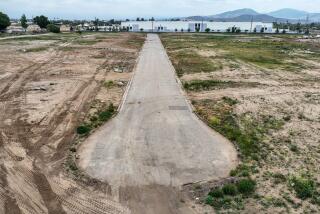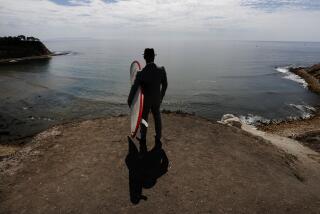Developer Accused of Destroying Wetlands : Ormond Beach: Federal officials want the 16.7-acre site restored to its natural state. The area is being used as a nursery.
- Share via
An Irvine development company destroyed 16.7 acres of ecologically valuable wetlands at an Oxnard beach and will probably be forced to restore the area to its natural state, federal officials said Wednesday.
In addition to the restoration, which could cost thousands of dollars per acre, the company could also receive up to $25,000 in administrative fines, Army Corps of Engineers staff said.
The Baldwin Co., which has proposed building a 4,100-home community on nearby land at Ormond Beach, bulldozed the 16.7-acre parcel in May to use as a nursery for garden plants.
The salt marshes that were destroyed support rare or endangered species of plants and animals and are among the last 1% to 5% of coastal wetlands that remain in the state, said Cathy Brown, wildlife biologist at the U. S. Fish and Wildlife Service.
Brown said it is illegal to clear or fill a wetlands without a permit, which Baldwin did not obtain.
“Because we’ve already lost so much of the coastal wetlands, the little that remains is disproportionately valuable,” she said. “They changed the hydrology, and that’s the lifeblood of a wetland.”
However, Robert Burns, president of Baldwin’s Los Angeles-Ventura division, said the company had not violated any laws. He said he had documents that show the area is not a wetlands.
“We believe we have a right to use the land for agricultural purposes,” Burns said. “Every document I have indicates that the area is not a wetlands.”
He said the company has not been notified by the corps and has not decided a course of action.
Brown said the complex ecosystem of the area will be difficult if not impossible to restore to its undisturbed state.
“Over time, it might come back to the way it was before,” she said. “But I don’t know that we really have any other options” other than to force the company to restore the area as much as possible.
Neither Baldwin nor the city of Oxnard has been notified of the corps’ findings, said Liz Varnhagen, a corps biologist.
She said the corps could impose administrative fines or take civil or criminal action against Baldwin, in addition to ordering restoration of the marsh.
“This is an area of high value and concern to us,” she said. “The corps is very concerned about the welfare of the coastal wetlands.”
Officials said the corps plans to release a report next week that includes its findings on the area.
Baldwin graded the land in May, raising the area high enough above the water to make it suitable for a plant nursery, Oxnard City Planner Matt Winegar said. No city permit was required because the amount of dirt moved fell below a threshold level, he said.
Baldwin proposes to build a small community of homes, condominiums, stores, a park and a school on 2,100 acres at Ormond Beach. The proposal is making its way through the city’s planning process and is expected to come up for a City Council vote in the spring, city officials said.
Winegar said Baldwin has been cooperative in the past on environmental issues, agreeing to scale back the proposed development from 10,700 homes to 4,100.
The area proposed for development is mainly east of Arnold Road and is covered with strawberry fields, tomato vines and vegetable crops. However, west of Arnold Road in the area where the 16.7 acres were bulldozed, much of the surrounding land is used for industry.
To the west of what is now a nursery dotted with acres of potted agapanthus and star lilies stands Halaco Engineering, a metal foundry where discarded materials form a large slag heap outside. To the east of the nursery is Southern California Edison Co. and its smokestacks. To the north is an open field and residential neighborhoods north of Hueneme Road.
But to the south are the white dunes and shores of Ormond Beach, where endangered least terns nest. In and around the area that was bulldozed, the rare Belding’s savannah sparrow breeds among the pickle weed, one of the plants that was plowed under, federal biologists said. The marsh also supports the endangered plant called the salt marsh bird’s beak.
Richard Burgess, a member of the Channel Islands branch of the statewide California Native Plant Society, said it was surprising that Baldwin had cleared the area.
“The Baldwin group has indicated they have been willing to be sensitive to the environment and here they have gone out and graded this marsh area,” he said.
More to Read
Sign up for Essential California
The most important California stories and recommendations in your inbox every morning.
You may occasionally receive promotional content from the Los Angeles Times.










